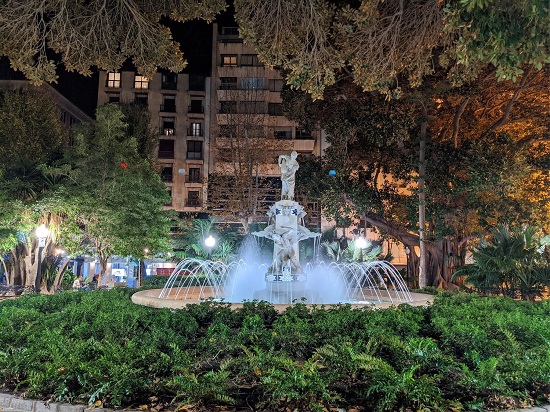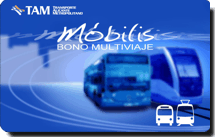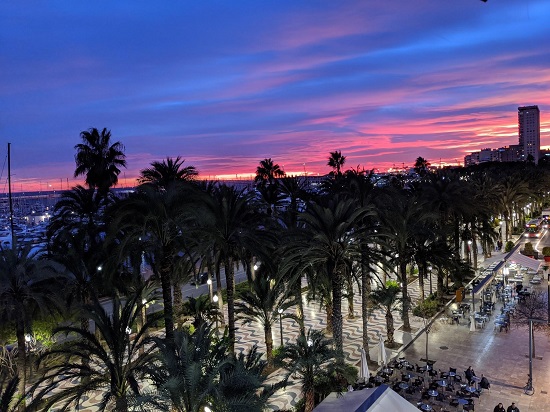As someone with a grid-like approach to transporting myself from place to place, I’m going to offer a few tips on navigating a foreign city. I studied abroad in Alicante, Spain, so for those of you heading to Costa Blanca, there will be some more specific advice toward the end of this post. (Pictured above: Unedited image of a sunset over the Explnada along the Alicante marina.)
Beginning with your arrival to your apartment and initial city introduction by the on-site staff, noting the surrounding main avenues gives you a good base from which to start exploring. After all, when asking for directions, most will be given based on these. As you walk anywhere, familiarizing yourself with the street names -- which in Spain are written on tiles on the buildings parallel to the street -- is extremely valuable not just for navigating day-to-day but for if you ever find yourself lost or without a cell phone or map.
One main way by which people give directions and orient themselves is with plazas and recognizable buildings and landmarks. The names of main plazas are important to know in most European cities, since they’re places where you can find public transportation as well as popular restaurants and shopping.
One thing that helped me not only become more accustomed to the layout of my study abroad host city but also find cool places I wouldn’t have otherwise wanted to explore was running. Seeing more of the city became efficient, and I really enjoyed experiencing how the mood and atmosphere of my area changed depending on the time of day. Even if running isn’t something you typically spend your time doing, a jog through your new home might be something you consider in your first couple weeks there.
ALICANTE TIPS
Public transportation is going to be your best friend in this lovely city as well as those nearby in the province. The CEA on-site staff in Alicante will give you a transportation card that you will need to refill with trips every week or so, depending on whether you buy 10 or 30 viajes (trips). We’ve done the math; it is not cheaper to buy in bulk, so if you’re afraid of losing the card, buying 10 trips at a time might be your best bet. Those trips on that card will allow you to take the tram every day from the city center to San Vicente del Raspeig where the University is located, a 26-minute ride with a gorgeous view of the Mediterranean.
You will also be able to travel to El Campello with those trips, but if you are wanting to travel outside Zone A on Tram Line 1, you will have to purchase a ticket from the same stations for the zone corresponding to your destination. It’s quite a simple transportation system, and the maps that the on-site staff will give you have almost all of the information you need to successfully navigate the tram lines for the duration of your time on Costa Blanca. I was able to travel north to Calpe and Altea using only the tram services, and I’d highly recommend going to those destinations at least once while there.
Lastly, the card will also work with the local bus system, and one trip within the city is normally the same cost as a trip to the university. There is also a quite reasonably-priced bus system that will take you to many of the cities and towns inside and out of the Alicante province, including Elche, Arenals del Sol (the beaches south of Alicante), Novelda, Alcoi, and many more. I was able to travel to Santa Pola for less than 5 euros for a day trip one weekend.
For the international travel plans I’m sure you will have, you’ll be pleased to hear that there is a bus that goes directly between the airport and the city center, making stops near Playa de Postiguet and along Alfonso Sabio, the main avenue on which the Mercado is located.
Lastly, I should mention the parking shortage within the city center. If you happen to make any local friends who have a car, it’s important to know that the “P” signs that claim parking “libre” do not mean that underground parking is free; rather, it signifies that there is vacancy or parking available that is paid for by the hour. Free parking is available on the streets north of Alfonso Sabio as well as near the MARQ tram station on the northeast side of Mount Benacantil and in front of Playa de Postiguet.
 |
| Highlighted locations mentioned in this article. |
Enjoy exploring!
Holly Hiatt is a CEA Alumni Ambassador who studied abroad in Alicante, Spain, during the Fall 2019 semester. She is currently a student at Humboldt State University.












